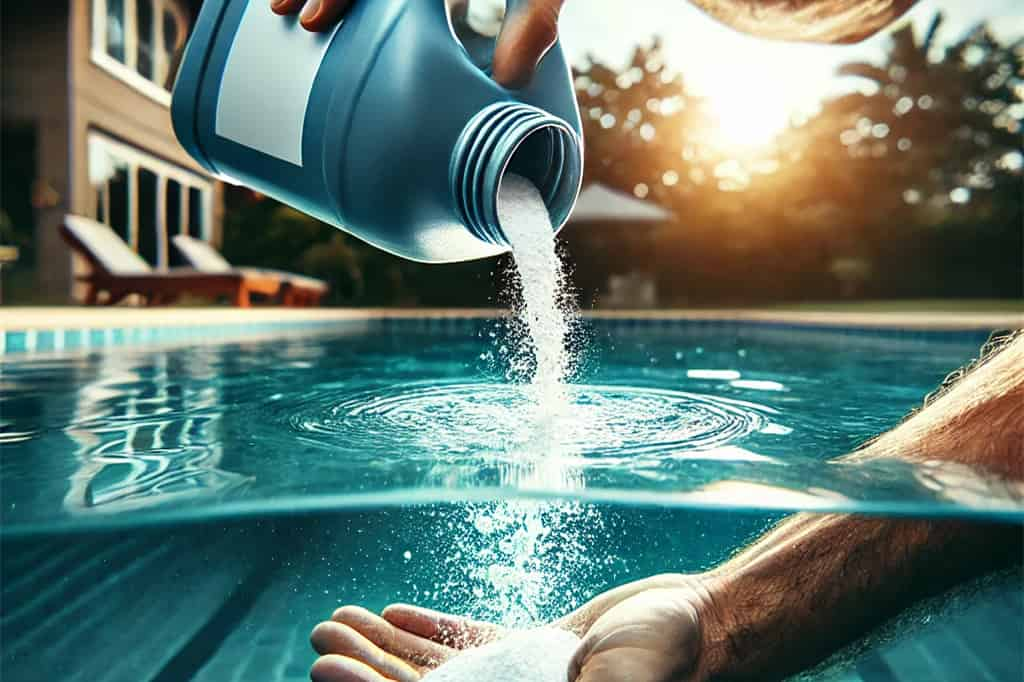Flocculants are an essential part of maintaining clear and clean water in swimming pools. These chemicals are designed to clump together tiny particles that make the water cloudy, allowing them to be more easily filtered out. If your pool water has turned hazy or murky despite regular filtration, adding flocculants can be an effective solution. However, a common question among pool owners is whether it’s safe to swim immediately after adding flocculants to the pool. In this blog, we’ll discuss how flocculants work, the safety considerations involved, and the best practices for using them.

How Flocculants Work
Flocculants are a type of chemical that causes small particles suspended in water to aggregate, forming larger particles called “flocs.” These flocs are too large to remain suspended in the water and thus sink to the bottom of the pool, where they can be vacuumed out or captured by the pool’s filtration system. This process is particularly useful when dealing with fine debris, algae particles, or dust that your regular filter may not be able to catch.
When you add flocculants to your pool, the chemical reaction begins almost immediately. However, the entire process of clearing the water can take several hours, as the flocs need time to form and settle. During this period, the pool water may look cloudy or murky, which is a normal part of the flocculation process.
Safety Concerns: Can You Swim After Adding Flocculants?
After adding flocculants to your swimming pool, it’s generally recommended to wait before swimming. Here’s why:
1. Chemical Reactions Are Still Ongoing
Flocculants are active chemicals, and when they are first added to the water, they begin to interact with the particles in the pool. While these reactions are not typically harmful to humans, it’s best to avoid swimming until the flocculants have had time to do their job. This usually means waiting until the flocs have formed and settled at the bottom of the pool, which can take anywhere from a few hours to overnight.
Swimming during this period could disturb the settling process, causing the particles to become suspended in the water again. This would negate the purpose of adding the flocculants and make the water cloudy once more.
2. Potential Irritation
While flocculants are generally safe when used correctly, they are still water treatment chemicals. Direct exposure to these chemicals in high concentrations could potentially cause skin irritation or discomfort. This is especially true for individuals with sensitive skin, as the chemicals might cause itching or redness. To minimize the risk, it’s best to wait until the flocculants have fully settled and the pool water has been filtered before swimming.
3. Slippery Surfaces
As the flocculated particles settle, they often create a layer of sediment on the bottom of the pool. This sediment can be slippery, increasing the risk of accidents or falls, especially if swimmers are not aware of it. Waiting to swim until after the pool has been vacuumed and the sediment removed ensures a safer swimming environment.
Best Practices for Using Flocculants
To ensure you get the most out of your flocculants and maintain a safe swimming environment, follow these best practices:
1. Pre-Clean Your Pool
Before adding flocculants, it’s a good idea to clean your pool as thoroughly as possible. Remove any large debris, brush the pool walls, and make sure your filtration system is functioning properly. This helps the flocculants work more effectively by focusing on the fine particles that are causing the cloudiness.
2. Read and Follow the Instructions
Always read the instructions on the flocculant packaging carefully. Different products may have varying concentrations and recommended usage amounts. Overdosing can lead to excessive sediment formation, while underdosing might not effectively clear the water. Ensure that you add the correct amount based on your pool’s size and water volume.
3. Distribute the Flocculant Evenly
When adding flocculants to your pool, make sure to distribute them evenly across the water surface. This can be done by walking around the pool and slowly pouring the flocculant into the water or by using a pool brush to spread it out. Even distribution ensures that all parts of the pool are treated effectively.
4. Allow Sufficient Time for Settling
After adding the flocculant, turn off your pool’s circulation system and allow the water to remain still. This helps the flocs form and settle at the bottom of the pool. The settling process usually takes several hours, so it’s best to do this in the evening and leave the pool overnight.
5. Vacuum the Pool Carefully
Once the flocs have settled, you’ll need to vacuum the sediment from the bottom of the pool. Use a manual pool vacuum rather than an automatic one, as the sediment can be delicate and easily disturbed. Vacuum slowly and carefully to ensure that you remove all of the sediment without stirring it back into the water.
6. Check and Adjust Water Chemistry
After vacuuming, it’s important to check your pool’s water chemistry. The addition of water treatment chemicals like flocculants can sometimes alter the pH and chlorine levels. Use a pool test kit to ensure that everything is balanced before allowing swimmers back into the pool.
Conclusion
In summary, while pool flocculants are an effective solution for clearing cloudy pool water, it’s important to wait before swimming after adding them. Allowing time for the chemical reactions to complete and the flocs to settle ensures that the pool is safe and clean for swimming. Following the best practices outlined above will help you use flocculants effectively, maintaining a sparkling, clear pool that’s enjoyable for everyone.
By understanding how these water treatment chemicals work and using them correctly, you can ensure that your pool remains a safe and inviting space. So, next time your pool water looks cloudy, remember that a little patience goes a long way in achieving that perfect swim-ready pool.





